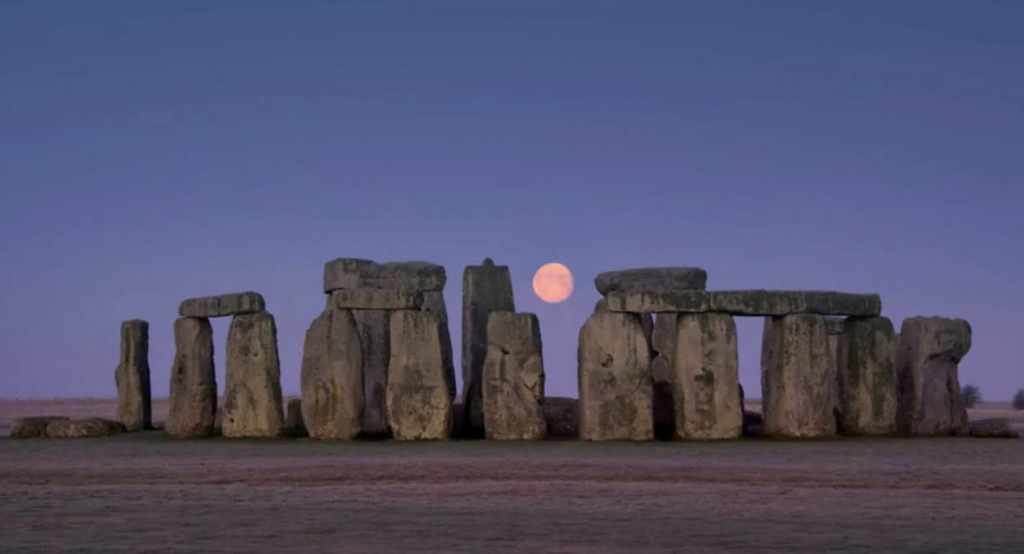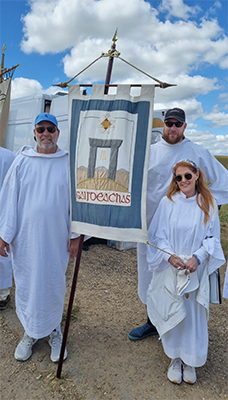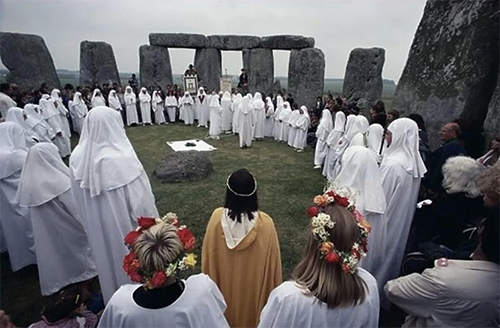
While traveling in Portugal last year to study the Knights Templars, my friends Laurel and Tim, and I met a fellow pilgrim, James Tod, an Englishman who produced the musical Six.
One afternoon, before I entered an ancient stone circle, as I customarily do, I was asking the guardians of the site if they would permit me to enter. As I thanked the ancient ones, I looked up to see that James was watching me, and he asked what I was doing. After I explained my sacred site ritual, James explained that he was one of the head Druids in England and invited my friends and me into Stonehenge with the Druids on the next Summer Solstice!
The Druids were philosophers, scholars, judges, mystics, and educators. They revered natural elements such as trees, particular oaks, rivers, and stones. They played a significant role in the spiritual life of their communities from around the 4th century BCE until the Roman conquest of these regions. Modern Druidism saw a revival of interest in the 18th and 19th centuries, and with that came the resurgence of honoring the summer solstice at Stonehenge. The Druids consider Stonehenge to be a significant cultural and spiritual symbol, and for centuries, they have gathered there annually to honor the solstices.
Stonehenge, located in Wiltshire, England, is one of the most famous prehistoric monuments in the world. Archaeological evidence indicates it was constructed between 3000 and 2000 BCE. The exact purpose remains a subject of debate, but some scholars believe it could have been an astronomical observatory because of the alignments of the stones with the equinoxes and solstices. It might have served as a site for religious ceremonies, possibly related to death and burial. It might have been a healing center. We know that in the medieval period, it was mentioned by several historical figures who linked it to the legendary wizard Merlin.
Before we met James in England, he provided us with a list of things we would be required to wear – everything would have to be white. White has always been important to Druids because it is deeply rooted in its symbolism of purity, spirituality, and connection to the natural and divine worlds. White is associated with light and illumination and the mythology of white animals.

From a Druid perspective, entering Stonehenge on the summer solstice is a deeply spiritual and ceremonial experience. They conducted three ceremonies to celebrate the longest day, and we were invited to participate in the three traditional ceremonies.
Midnight Ceremony -Midnight Vigil
Druids gather at sacred sites, such as Stonehenge or other ancient stone circles, to keep vigil through the night. – They light a sacred fire, which symbolizes the sun’s journey and the life-giving energy it provides. Participants engage in chanting, drumming, and storytelling, often sharing myths and legends related to the solstice. This ceremony honors the transition from darkness to light and sets the tone for the following day’s celebrations.
Our midnight ceremony was on a dark, rainy English night, and I had four layers of clothing on, and even though it was June 21, I was freezing. After we walked about two miles in a silent single file, we arrived at a mound in the middle of a field. The Druids gathered in a circle, and we, their guests, filed in behind them, creating an outer circle. After the ceremony, we returned the way that we came.
 Sunrise Ceremony – Greeting the Dawn
Sunrise Ceremony – Greeting the Dawn
Our second ceremony began around 3 am. As the sun rose, it aligned perfectly with the Heel Stone, which casts rays through the ancient stones. All the Druids gathered in white robes, symbolizing purity and connection to nature. A horn was sounded to herald the dawn, symbolizing the triumph of light over the darkness. We were then divided into four groups to honor the four elements, and we all faced the direction of the rising sun. The air was filled with the sounds of drums, chanting, and the scent of burning herbs, creating a sacred atmosphere. The ceremony began with an invocation to the sun, thanking it for its life-giving energy and asking for blessings. When the invocation was over, we formed a circle, holding hands, and engaged in rituals such as lighting the central fire, offering libations, or conducting a meditation to honor the Earth and the ancestors. Standing there, I knew that the Druids saw this moment as a time to connect with the cycles of nature, to reflect on personal growth, and to seek guidance for the coming year. This moment was a time of renewal and rebirth, reflecting the new beginnings associated with the solstice. The experience to me was one of unity, reverence, and a profound sense of connection to the ancient traditions and the natural world.
Noon Ceremony
At noon, when the sun is at its highest point in the sky, Druids and their guests gather once more for a final ceremony. This ceremony included offerings of flowers, herbs, and other natural items, symbolizing abundance and fertility. We engaged in meditative practices, focusing on personal growth and the harnessing of the sun’s energy for inner strength. The culmination of the day’s rituals involved a communal meal, celebrating the harvest and the community’s bonds.
 All three of these ceremonies collectively honor the sun’s journey and the cycle of nature, emphasizing themes of light, growth, and renewal.
All three of these ceremonies collectively honor the sun’s journey and the cycle of nature, emphasizing themes of light, growth, and renewal.
Today, over a million people go annually!
The Druids remain a fascinating and mysterious part of history, symbolizing a deep connection to nature and a rich spiritual tradition.
Are you wearing the best colors for you? Each of us has a power color based on the five elements and the day we were born. Sign up for my email list and provide me the day, month, and year of your birth, and I will send you your birth element and power color!
Want more tips on creating a meaningful life? Subscribe to my podcast, Creating a Meaningful Life, and follow for more inspiration!

It’s Knights Templar, not ‘Templer”.
Thank you for letting me know. I’ve fixed it.